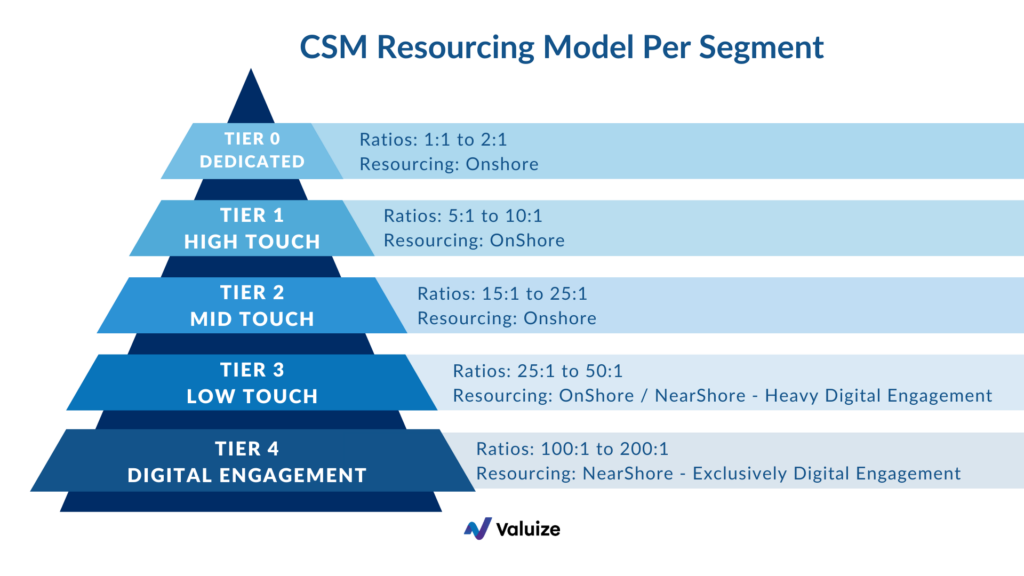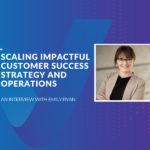Assemble Your Customer Success Organization Around Value Delivery
Customer segmentation is a vital activity for recurring revenue businesses. Without a clear customer segmentation model, you risk failing to deliver value, retain customers and successfully scale your business. By implementing a data-driven customer segmentation, your organization will be empowered to craft a tailored strategy that targets your product development, messaging and activities to the right customers at the right place at the right time. The key to leveraging this powerful model is to determine the specific needs of each customer segment so that you can effectively and efficiently distribute your resources to serve all your customers better.
In this article, we outline how you can optimize your organization and scale your segmentation model to meet your customers’ needs and exceed their expectations to enable maximum value realization across your entire customer base.
Be Thoughtful About Your Customer-to-CSM Ratio
It’s not uncommon for leaders to look elsewhere in their business for inspiration when first establishing their ideal customer-to-Customer Success Manager (CSM) ratio. Often, leaders will replicate their Sales-to-accounts assignment and implement a similar ratio in their Customer Success (CS) organization. However, there are risks associated with this approach. Sales reps, unlike CSMs, don’t have a consistent or constant touch point with the customer. Usually, Sales reps will dip in and out of accounts at fairly long intervals, whereas CSMs walk in constant lockstep with the customer throughout their journey. Your CSMs need to have the bandwidth to deliver value and outcomes with that customer consistently throughout their journey; otherwise, they may become overwhelmed and oversaturated with tasks that impede their ability to effectively and successfully deliver value. So, when you’re resource planning for your customer segmentation model, you should automatically budget for a slightly lower customer-to-CSM ratio than the other ratios in your business to date.
As you get more granular and establish CSM assignment per customer segment, the specific needs of each segment should drive your resource allocation. Your top tier accounts are going to have the lowest customer-to-CSM ratio because they have a more complex ecosystem with deeper executive chains, which means your CSMs are going to need more time for relationship management and value messaging. As you get into your tier two and three accounts, you can afford to slightly increase your ratios, but you should always be thinking about how you can drive the greatest value and allocate resources accordingly. Automation and digital engagement will be crucial to helping your CSMs service these segments, especially your tier four, effectively.

For a detailed breakdown of how to approach your segmentation coverage and investment, here is a strategic and scalable approach to segmenting your customer base.
Invest In Customer Success Operations
From our experience, a costly mistake that leaders often make is under-investing in Customer Success Operations. As your customer base grows and your organization expands, you need to invest in an operations team to help you successfully execute and serve your Customer Success Management base while maintaining a reasonable Cost-To-Serve. CS Operations leaders are often overlooked because they aren’t directly connected to a client, but every single Operations person serves your whole client base and generates a higher ROI for your investment. While some leaders prefer to spend their budget on hiring additional CSMs, they can only cover so many accounts. On the other hand, the right CS Operations leader will help you maximize scale across hundreds of accounts instead of just a dozen.
Leverage Data
It’s a common practice for companies to begin their Customer Success motion in their top tier accounts. However, it’s important to remember that what works for your tier one isn’t necessarily going to scale or add value to your lower tiers, and vice versa. To ensure that you’re allocating resources effectively, you need to have the ability to utilize and analyze the data that’s in your ecosystem to ensure that your customer ratios and CSM activities are on point. Through continuous evaluation of your data, you can determine if you need to hire an extra Operations person to run the digital journey, manage the adoption resource hub or to maintain the Gainsight instance to guarantee continuous value delivery to your entire customer base.
Invest In A Dedicated Customer Success Technology Platform
As your company grows, the complexity and sheer volume of tasks means that your CSMs are going to get disorganized and overwhelmed without a dedicated Customer Success technology platform in place. CS technology is explicitly designed to help maintain customer data longitudinally, not just at one point in time, and a well structured and operationalized Customer Success management platform will help you predict future trends in addition to attending to your current needs. That longitudinal view, and the ability to see it across your entire customer base, all in one place, is critical as you start to scale.
Time is a really valuable resource. In the time it takes your CSM to manually research whether they need to reach out to a customer, they could have reached out to two or three customers if prompted by a Customer Success management platform. Using time-based alerts and other prompts allows your CSMs to see through the noise, manage their time efficiently and optimize customer engagements accordingly. When you think about your particular customer segments, especially tier three and tier four, it’s critical to create efficiencies in how your team engages with those customers. This includes tasks like automated messaging, templatizing your emails, and automatically capturing data so that you can reduce your administrative overhead. The best version of a CS platform is one that helps your CSMs stay organized and also allows your senior executives, and managers of CSMs, to digest customer information from one place and get a clear and immediate snapshot of your entire customer base.
If you’re currently in the process of evaluating which Customer Success technology is right for your organization, here are 6 critical criteria to consider.
Prune & Weed Your Processes
A crucial step to ensuring effective resource allocation, and making the most of your CSMs’ time and energy, is weeding out activities and tasks that don’t drive value. Using the vast amounts of data readily available in your ecosystem, you can definitively determine if a certain activity moves the needle for your customers or not. If it does, you can then apply that activity to your other customers at scale. If not, you can remove that activity from your CSMs responsibilities, saving them, and your customers, time and money.
As is often the case, CSMs become catchalls – they pick up work that should be the responsibility of other teams in your organization. A frequent example is CSMs taking on tasks from the Support team, such as responding to tech issues, which results in an inflated workload. Ensure that your CS organization leaders have identified whether your CSMs are picking up work that you have resourced and invested elsewhere and remove that from their plate so that they can focus on serving their customers effectively.
Create Efficiencies Through Data-Driven Insights
The best customer segmentation model and strategy is one that is continuously updated based on data-driven insights. Your customers are constantly evolving, as are their needs and goals, so the way you engage with and service them needs to keep pace. This requires constant evaluation of your team, tools and processes to ensure maximum value is delivered to each customer segment consistently and sustainably.
Is your organization operating at peak performance? Read our recent article about the 5 stages of operational improvement to learn how you can make your CS organization more efficient and effective.





